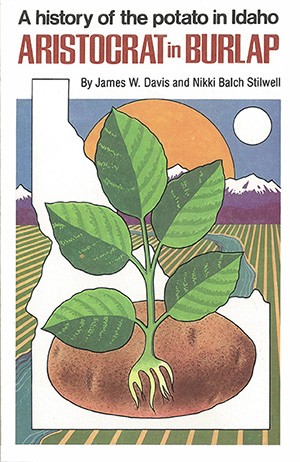 High school girls harvested a bountiful potato crop in 1943.
High school girls harvested a bountiful potato crop in 1943.
Potato diggers were slow to improve. They were designed primarily to unearth the potatoes and leave them exposed on top of the ground, to be picked by hand and put in field bags. Harvest time required many hands and people who did not do field work any other time of year were recruited to pick potatoes in the annual September -October race against the freeze-up. The pickers filled their field bags about half-full, and they were loaded on wagons to be hauled from the fields and dumped in potato cellars. The soft soil in the harvest fields frequently made three teams of horses necessary to pull a wagonload of potatoes from the field. Once on the road, two teams could usually pull the wagon to town for storage or shipment. When trucks became available, the transportation problem of hauling crops to market lessened.
As harvest labor became harder to get, machinery designers began to improve diggers. The use of chain-link conveyors to separate field dirt from potatoes soon led to a more-complex machine that elevated the potatoes in bulk to the height of a potato truck and eliminated hand-picking and field bags. Space was provided on some harvesters for people to stand so they could remove vines, trash, clods of soil, and field stones. These potato harvesters revolutionized field work by eliminating hand-picking and the lifting of bagged potatoes for loading. The flood gates were open for big operations and potato fields got larger and larger.
The Mormon pioneers in Franklin County dug irrigation canals and brought the water to their crops by gravity flow. From lateral ditches, the water was diverted to flow down the rows of potato plants in fields. For many years, nearly all of the irrigation in the West was done by gravity. Water had to originate from a reservoir or dam at a higher elevation and the land to be farmed had to be level for efficient gravity irrigation.
A major breakthrough was the development of sprinkler irrigation. The facts are not available as to who did the first irrigation with sprinklers in Idaho, but by the late 1940s, the trend had begun. A major factor was the development of light-aluminum sprinkler pipe that could be moved from one part of the field to another. These are called handlines. One of the big advantages of sprinkling is that it is no longer necessary to have flat ground. The system adapted to the gently rolling hills of much of Idaho's unreclaimed desert areas and made possible the addition of thousands of new acres of potato ground.


 High school girls harvested a bountiful potato crop in 1943.
High school girls harvested a bountiful potato crop in 1943.